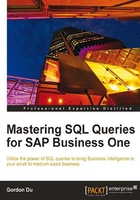
What this book covers
There are two sections present in this book.
Section 1: SQL Query Basic
The first section is mainly for beginners who have limited knowledge of SQL Query but want to use this tool as soon as possible. You will learn basic tools to start writing your query quickly. Upon completion, you could jump to the next section to further your skills to complete more. Section 1, SQL Query Basic comprises three chapters:
Chapter 1, SAP Business One Query Users and Query Basics, discusses the basic concepts and knowledge needed to use SQL query in SAP Business One. You will learn a clear definition of SQL query, the data dictionary, and table links.
Chapter 2, Query Generator and Query Wizard, introduces two basic tools for SAP Business One. Query Generator and Query Wizard will teach you to create SQL query in SAP Business One quickly to get the job done.
Chapter 3, Query Manager, illustrates the most important business intelligence tool for SAP Business One. Query Manager will help you write query freely. This chapter covers the most frequently used query statements one by one. All statements are explained with concrete examples.
Through these three chapters, you will gain the basic knowledge to jump to the next section and have to use SQL query in more areas. Even experienced readers may find some value in going through this section.
Section 2: SQL Query in Action
The second part of the book will jump to a higher level of complex SQL queries. You will learn different skills for different categories. This section is more closely related to Business Intelligence more closely because it can retrieve more business required data at the right time by the right people. Section 2, SQL Query in Action comprises six chapters:
Chapter 4, Query Examples, shows the most widely used query examples. You will learn more query features first. By showing query examples from three primary usage categories, you will be able to build the queries to meet your specific need. The alert query examples are discussed especially for those important on-demand situation.
Chapter 5, Securities and Approval, describes the security for query by SAP Business One and also the query associated with approval processes. You will learn how to handle query security by utilizing query groups. You will also learn user query for approval procedures with query examples.
Chapter 6, SQL Query for Formatted Search (FMS), emphasizes one of the most frequently used and error-prone processes to create SQL Query for Formatted Search (FMS). You will learn everything needed in FMS query and the associated Auto Refresh functionality.
Chapter 7, SQL Query for Other Reporting Tools, focuses on SQL query usage in some other reporting tools. You will learn Query Print Layout Designer as well as the SQL query usage within Crystal Reports. The latter focuses on Command in the database expert selection of Crystal Reports.
Chapter 8, SQL Query for Stored Procedure (SP), is about one of the very special cases for query usage. You will learn query that is used in a special Stored Procedure: SBO_SP_TransactionNotification. By giving a clear overview of the SP, the last section shows some kernel SQL query examples for this SP.
Chapter 9, More Complicated SQL Query Topics, extends the scope of basic SQL query to more complicated cases. You will get in depth query knowledge to bring more Business Intelligence into SAP Business One. At the end of the book, you will get some good advices about query writing.
Through these six chapters, you will gain more knowledge regarding SQL query for SAP Business One. If you have specific questions in mind, you may jump to the chapter that most attracts you and go from there.
Each chapter contains specific query examples. For ease of reference in Chapters 4 and 9, each example refers to the chapter number, along with a letter code denoting the subject of the query. Please refer to the following key:
